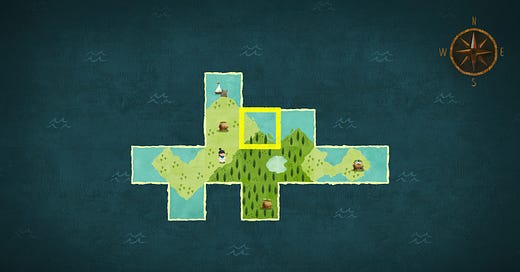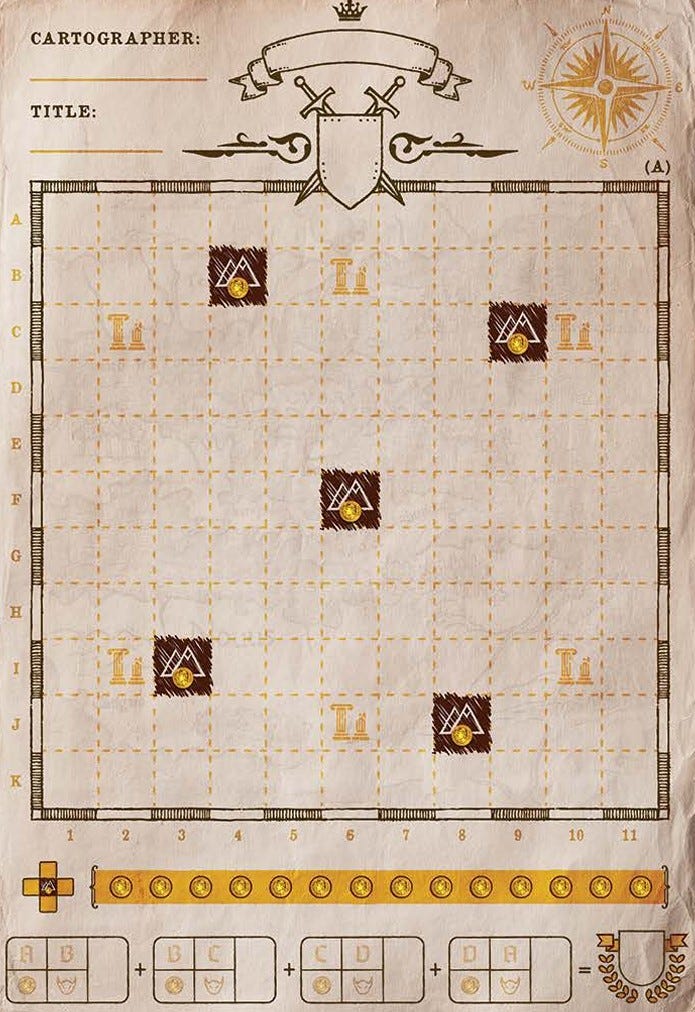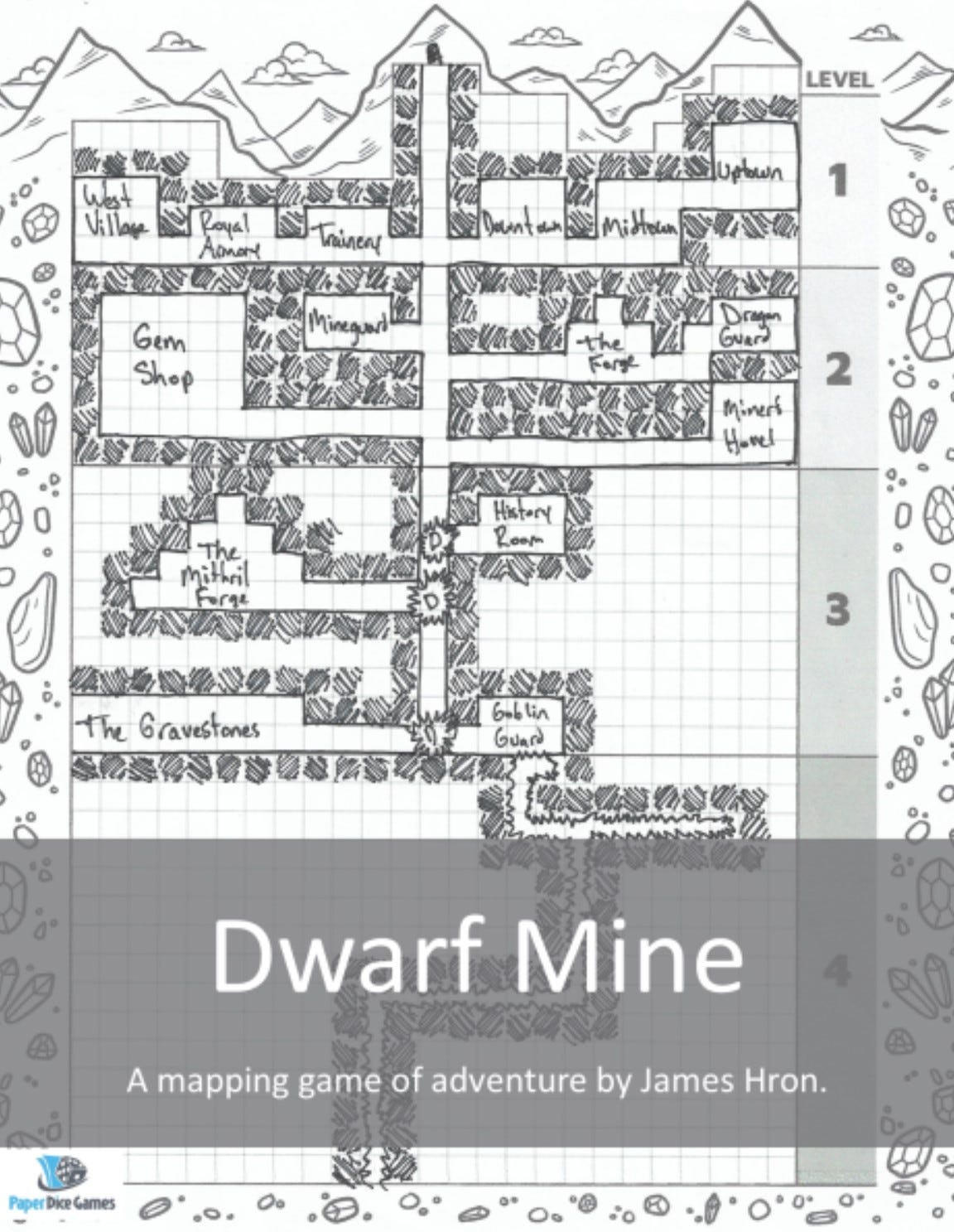Design Inspiration/Game Reviews: Map-making as Gameplay
A look at games about creating maps, and what they have taught me about designing my own storytelling games.
Among the many projects I am actively working on right now, my primary focus is currently on my entry for this year’s PocketQuest game jam for DrivethruRPG. I always try to challenge myself to do something unexpected with the core mechanics and gameplay loop of my PocketQuest designs: Good Nature uses cooperative dice-matching, Into the Starlit Sky uses a tarot deck for sci-fi prompts, and G.E.M.S. creates a board game out of cards.
For this year’s project, I am starting with the Story & Color system I created for A Butterfly Story and Paper Pixel Prologue, and adapting it into a game that has map-making as the central game mechanic. As I develop my own map-making storytelling game, I wanted to offer some thoughts on how other games that use map creation as a core component of their gameplay have inspired my latest design.
Board Game: Cartographers (Thunderworks Games, 2019)
Cartographers can be summed up as “map-drawing meets Tetris”. Every turn, you reveal a card that tells you what to add to your map. The cards will indicate the terrain type and a shape that can be rotated (sometimes with choices for these traits) and then you figure out how to add that combination to your grid. There are also objectives for each round that determine how many points you score, such as “filling a whole row with forest” or “each farmland adjacent to a river”, that give you some focus on how you’ll want to layout the pieces you are given.
It plays seamlessly as a solo game, but is also a lot of fun in multiplayer: monster raid cards have you pass your map to another player who then draws in the monsters on your sheet, altering your map and negating possible points. Everyone’s map ends up very different, making the final reveal at the end a fun art share.
The game plays quickly and is easy to learn. Highlights of the gameplay loop and its map-drawing mechanics are:
The cards keep every game unique: The deck is shuffled, only one card is revealed and drawn onto your map at a time, and surprise monster raids allow others to alter your map. All of these elements make each playthrough result in a completely different layout by the end of the game.
Every addition to your map is an active choice: The cards tell you what to draw, but you decide how to rotate it and where to place it. You are constantly assessing available space, expanding or blocking regions, and considering the scoring objectives for the round.
You can plan and strategize: Card draws and objectives are randomized every game, and only two of the four objectives are scored each round, but you always know which objectives are active and which are coming up later.
Video Game: Carto (Sunhead Games, 2020)
Carto is a charming adventure/exploration game in which you travel across islands searching for items. There is no combat, just travel, item collecting, and NPC interactions that open up new areas and advance the story. The core mechanic of the game is finding map pieces that then grant you new areas to explore, which you place on your map to expand and alter the game world. Where and how you place these pieces will determine where you can travel to, which other characters can move into new locations, and what items you can now access. You can even continue to move pieces after they have been placed, allowing you to constantly alter the world as needed for quest and character interactions.
My favorite parts of Carto’s use of map-making as gameplay:
Exploration is Everything: The game is strictly about moving around, discovering new things, and figuring out where items or characters are located and where to take them once found. As a map-making game, it goes all-in on “discovery” as the main player experience.
Change and Experimentation are Key: The layout of the world in Carto is never set in stone. Every map tile can be rotated and placed somewhere new again and again. Many puzzles require moving locations back and forth, and most challenges can be solved using a variety of routes depending on which map pieces you have available and how creative you get with their placement. There are also many interactions that appear based on how two map tiles are placed next to each other.
Location is Storytelling: So much of Carto’s story becomes available and is developed further by the expansion and transformation of the physical space. Your design of the map creates connections and solves problems for the characters you interact with.
TTRPG: Dwarf Mine (PaperDice Games, 2020)
Evoking classic computer games like Dungeon Keeper, Dwarf Mine is map-making as a strategy management game. The gameplay loop has you adding tunnels and rooms to your mine, rolling on tables for treasure, combat, and events, and managing resources and building prestige to continue building and delving into deeper levels underground. The rule book encourages storytelling elements, including name generators for new locations, many event and encounter tables that serve as both game events and writing prompts, and a spot on the Mine sheet to track the history of the mine as you encounter new events and add new rooms.
Dwarf Mine does a lot to create a whole strategic TTRPG experience around designing a unique map:
Locations are Abilities: Building rooms and adding them to your map is the primary action of the game. There is a long list of room templates to build, each of which grants some effect or ability. What you create and add to your map determines not only your overall progress, but also what actions and responses are available to you.
Resources Make Choices Matter: Every turn offers you a chance to collect treasure, gold, gems, and ore. What do these things do? They are currency and resources for building rooms, activating abilities, and gaining prestige (Dwarf Mine’s score value). Having resources that are tracked and can be exchanged for benefits gives the player many choices, all of which affect something else in the game and measure your success.
Combat in a Drawing Game: For a game all about building a mine and drawing a map, Dwarf Mine has a fun and satisfying combat system. Every turn, your mine is attacked by creatures. Combat is just two die rolls (one for your mine, one for the invaders) and goes on until one side is vanquished. It’s quick and seamless, adding a dynamic threat to the game without taking the focus away from creating your map.
Have you played games that have you create maps as a core mechanic? Any games you would recommend that use such experiences in innovative ways? Let me know in the comments!







